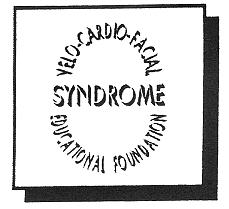Velo-Cardio-Facial Syndrome
 Velo-cardio-facial syndrome (VCFS), also known as Shprintzen syndrome,
Velo-cardio-facial syndrome (VCFS), also known as Shprintzen syndrome,
sometimes presenting as the DiGeorge sequence, is caused by a deletion of a small segment of the long arm of chromosome 22. It is one of the most common genetic
disorders in humans. The following list shows the anomalies which have been found
in VCFS. No findings have a 100% frequency, but all occur with sufficient
frequency to warrant assessment if suspected. If you have any questions, or if you
would like to learn more about VCFS, you may reach The Velo-Cardio-Facial
Syndrome Educational Foundation by telephone at 315-464-6590, by fax at 315-464-5321, or by email at [email protected]
Craniofacial/Oral Findings
2. Retrognathia (retruded lower jaw) 3. Platybasia (flat skull base) 4. Asymmetric crying facies in infancy 5. Structurally asymmetric face 6. Functionally asymmetric face 7. Vertical maxillary excess (long face) 8. Straight facial profile 9. Congenitally missing teeth 10. Small teeth 11. Enamel hypoplasia (primary dentition) 12. Hypotonic, flaccid facies 13. Downturned oral commissures 14. Cleft lip (uncommon) 15. Microcephaly 16. Small posterior cranial fossa Eye Findings 17. Tortuous retinal vessels 27. Retinal coloboma (uncommon) 28. Small eyes 29. Mild orbital hypertelorism 30. Mild orbtal dystopia 31. Puffy eyelids Ear/Hearing Findings 32. Overfolded helix 33. Attached lobules 34. Protuberant, cup-shaped ears 35. Small ears 36. Mildly asymmetric ears 37. Frequent otitis media 38. Mild conductive hearing loss 39. Sensori-neural hearing loss 40. Ear tags or pits (uncommon) 41. Narrow external ear canals Nasal Findings 42. Prominent nasal bridge 46. Narrow nasal passages Cardiac Findings 47. VSD (Ventricular septal defect) 48. ASD (Atrial septal defect) 49. Pulmonic atresia or stenosis 50. Tetralogy of Fallot 51. Right sided aorta 52. Truncus arteriosus 53. PDA (patent ductus arteriosus) 54. Interrupted aorta 55. Coarctation of the aorta 56. Aortic valve anomalies 57. Aberrant subclavian arteries 58. Vascular ring 59. Anomalous origin of carotid artery 60. Transposition of the great vessels 61. Tricuspid atresia Vascular Anomalies 62. Medially displaced internal carotid arteries 63. Tortuous, kinked, absent, or accessory internal carotids 64. Jugular vein anomalies 65. Absence of vertebral artery (unilateral) 66. Low bifurcation of common carotid 67. Tortuous or kinked vertebral arteries 68. Reynaud’s phenomenon 69. Small veins 70. Circle of Willis anomalies Neurologic and Brain Findings 71. Periventricular cysts (mostly at anterior horns) 72. Small cerebellar vermis 73. Cerebellar hypoplasia/dysgenesis 74. White matter UBOs (unidentified bright objects) 75. Generalized hypotonia 76. Cerebellar ataxia 77. Seizures 78. Strokes 79. Spina bifida/meningomyelocele 80. Mild developmental delay 81. Enlarged Sylvian fissure Pharyngeal/Laryngeal/Airway Findings 82. Upper airway obstruction in infancy 83. Absent or small adenoids 84. Laryngeal web (anterior) 85. Large pharyngeal airway 86. Laryngomalacia 87. Arytenoid hyperplasia 88. Pharyngeal hypotonia 89. Asymmetric pharyngeal movement 90. Thin pharyngeal muscle 91. Unilateral vocal cord paresis Abdominal/Kidney/Gut 92. Hypoplastic/aplastic kidney 93. Cystic kidneys 94. Inguinal hernias 95. Umbilical Hernias 96. Malrotation of bowel (single case) 97. Hepatoblastoma (single case) 98. Diaphragmatic hernia (single case) 99. Anal anomalies (displaced, imperforate) |
Limb Findings 100. Small hands and feet 101. Tapered digits 102. Short nails 103. Rough, red, scaly skin on hands and feet 104. Morphea 105. Contractures 106. Triphalangeal thumbs 107. Polydactyly (both preaxial and postaxial) 108. Soft tissue syndactyly Problems in Infancy 109. Feeding difficulty, Failure-to-thrive 110. Nasal vomiting 111. Gastroesophageal reflux 112. Nasal regurgitation 113. Irritability 114. Chronic constipation (not Hirschsprung megacolon) Speech/Language 115. Severe hypernasality 116. Severe articulation impairment 117. Language impairment (usually mild delay) 118. Velopharyngeal insufficiency (usually severe) 119. Dyspraxia 120. High pitched voice 121. Hoarseness Cognitive/Learning 122. Learning disabilities (math concept, reading cmprehension) 123. Concrete thinking, Difficulty with abstraction 124. Drop in IQ scores in school years (test artifact) 125. Borderline normal intellect 126. Occasional mild mental retardation 127. Attention deficit hyperactivity disorder Miscellaneous anomalies 128. Spontaneous oxygen desaturation without apnea 129. Thrombocytopenia 130. Bernard-Soulier disease 131. Juvenile rheumatoid arthritis Psychiatric/Psychological 132. Bipolar affective disorder 133. Manic depressive illness and psychosis 134. Rapid or ultrarapid cycling of mood disorder 135. Mood disorder 136. Depression 137. Hypomania 138. Schizoaffective disorder 139. Impulsiveness 140. Flat affect 141. Dysthymia 142. Cyclothymia 143. Social Immaturity 144. Obsessive compulsive disorder 145. Generalized anxiety disorder 146. Phobias Immunologic 147. Frequent upper respiratory infections 148. Frequent lower airway disease (pneumonia, bronchitis) 149. Reduced T cell populations 150. Reduced thymic hormone 151. Reactive airway disease Genitourinary 152. Hypospadias 153. Cryptorchidism 154. G-U reflux Endocrine 155. Hypocalcemia 156. Hypoparathyroidism 157. Pseudohypoparathyroidism 158. Hypothyroidism 159. Mild growth deficiency, relative small stature 160. Absent, hypoplastic thymus 161. Hypoplastic pituitary gland Skeletal/Muscle/Orthopedic/Spine 162. Scoliosis 163. Hemivertebrae 164. Spina bifida occulta 165. Butterfly vertebrae 166. Fused vertebrae (mostly cervical) 167. Tethered spinal cord 168. Syrinx 169. Osteopenia 170. Sprengel’s anomaly, scapular deformation 171. Talipes equinovarus 172. Small skeletal muscles 173. Joint dislocations 174. Chronic leg pains 175. Flat foot arches 176. Hyperextensible/lax joints 177. Extra ribs 178. Rib fusion Skin/Integument 179. Abundant scalp hair 180. Thin appearing skin (venous patterns easily visible) Secondary sequences/associations 181. Robin sequence 182. DiGeorge sequence 183. Potter sequence 184. CHARGE association 185. Holoprosencephaly (single case) |
Some other facts about the syndrome:
|
|
For more information regarding velo-cardio-facial syndrome, call, write, or email the Educational Foundation:
Dr. Robert J. Shprintzen
The Velo-Cardio-Facial Syndrome Educational Foundation
Jacobsen Hall, 707
SUNY Health Science Center at Syracuse
750 East Adams Street
Syracuse, NY 13210
Phone: 315-464-6590 Fax: 315-464-5321